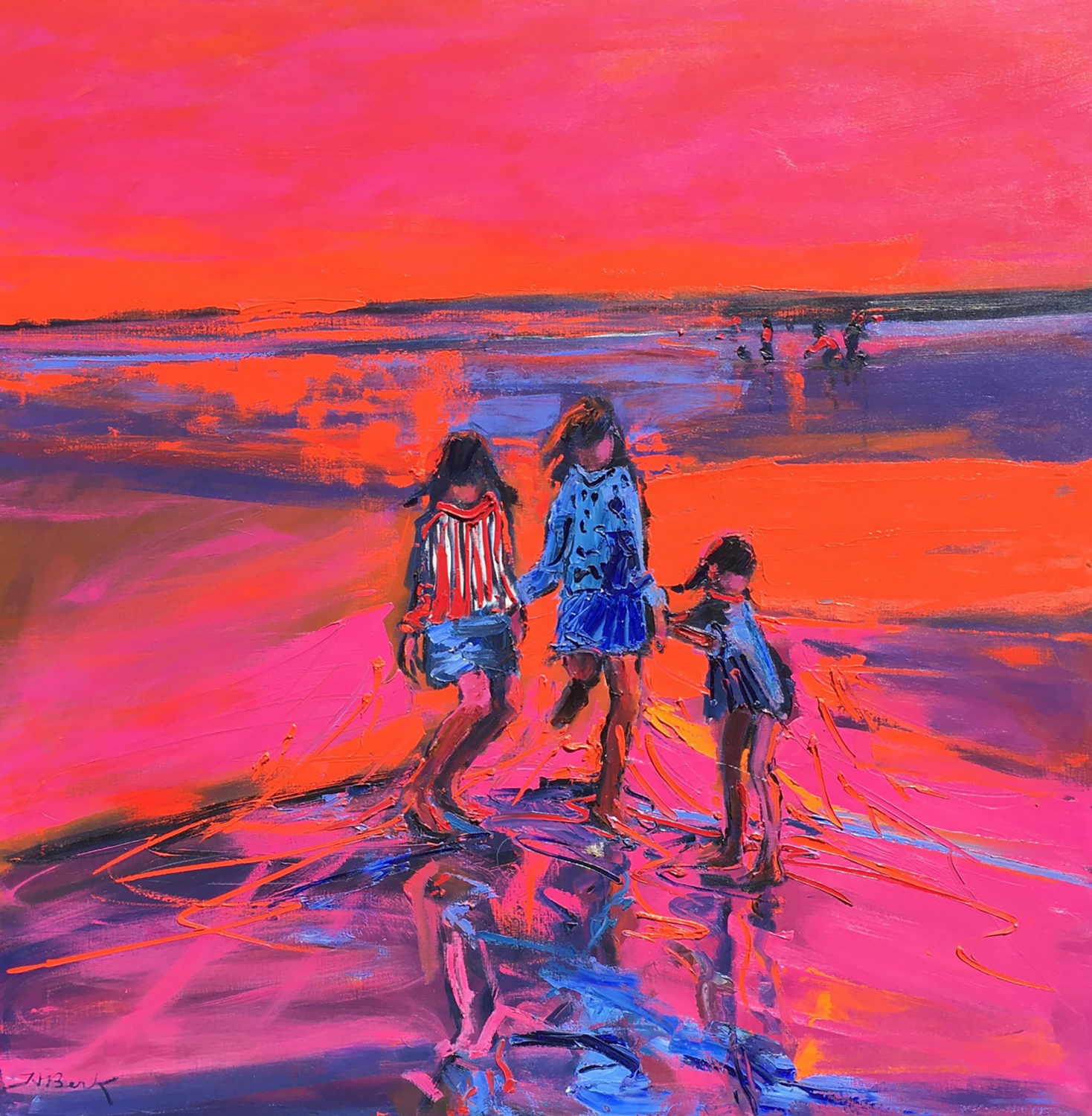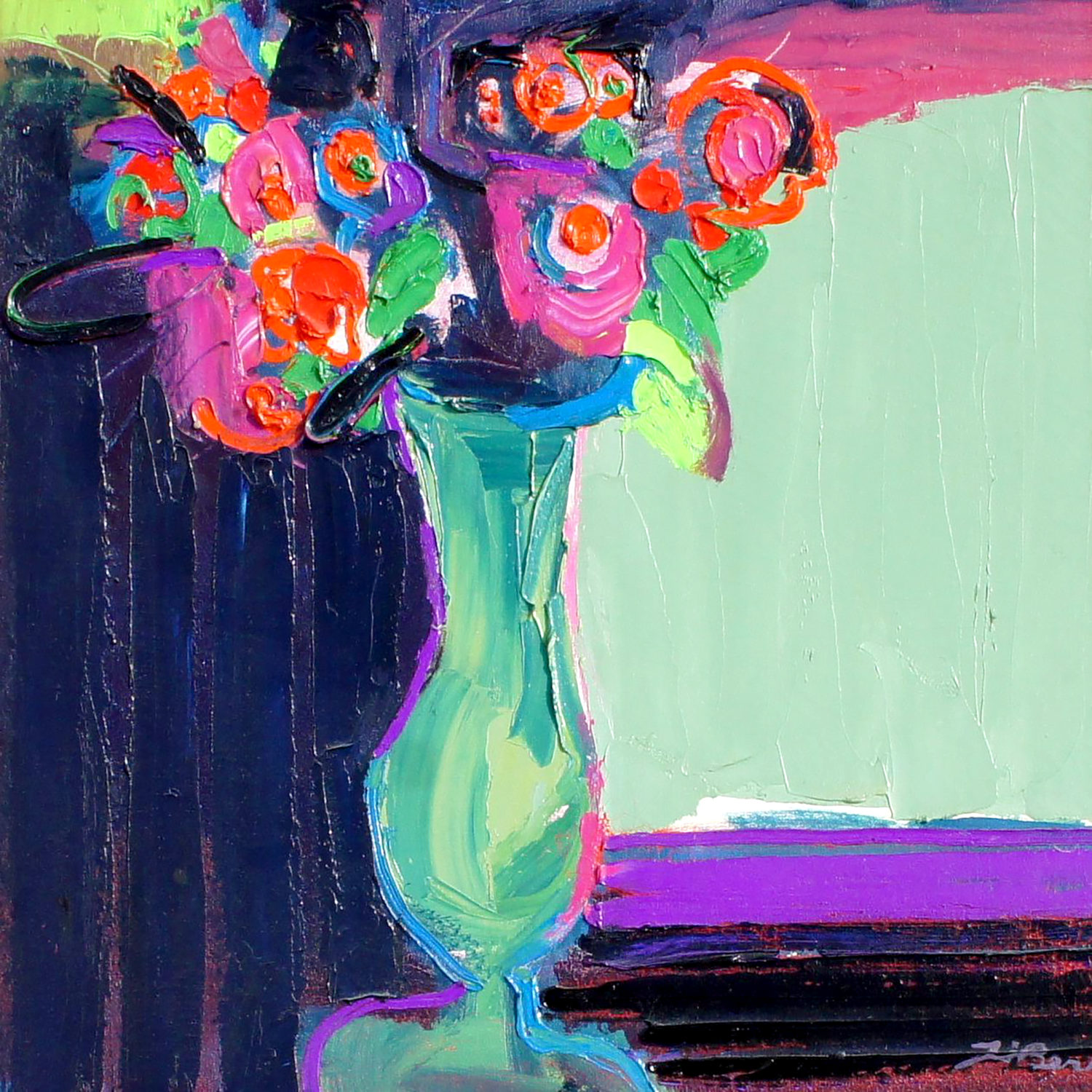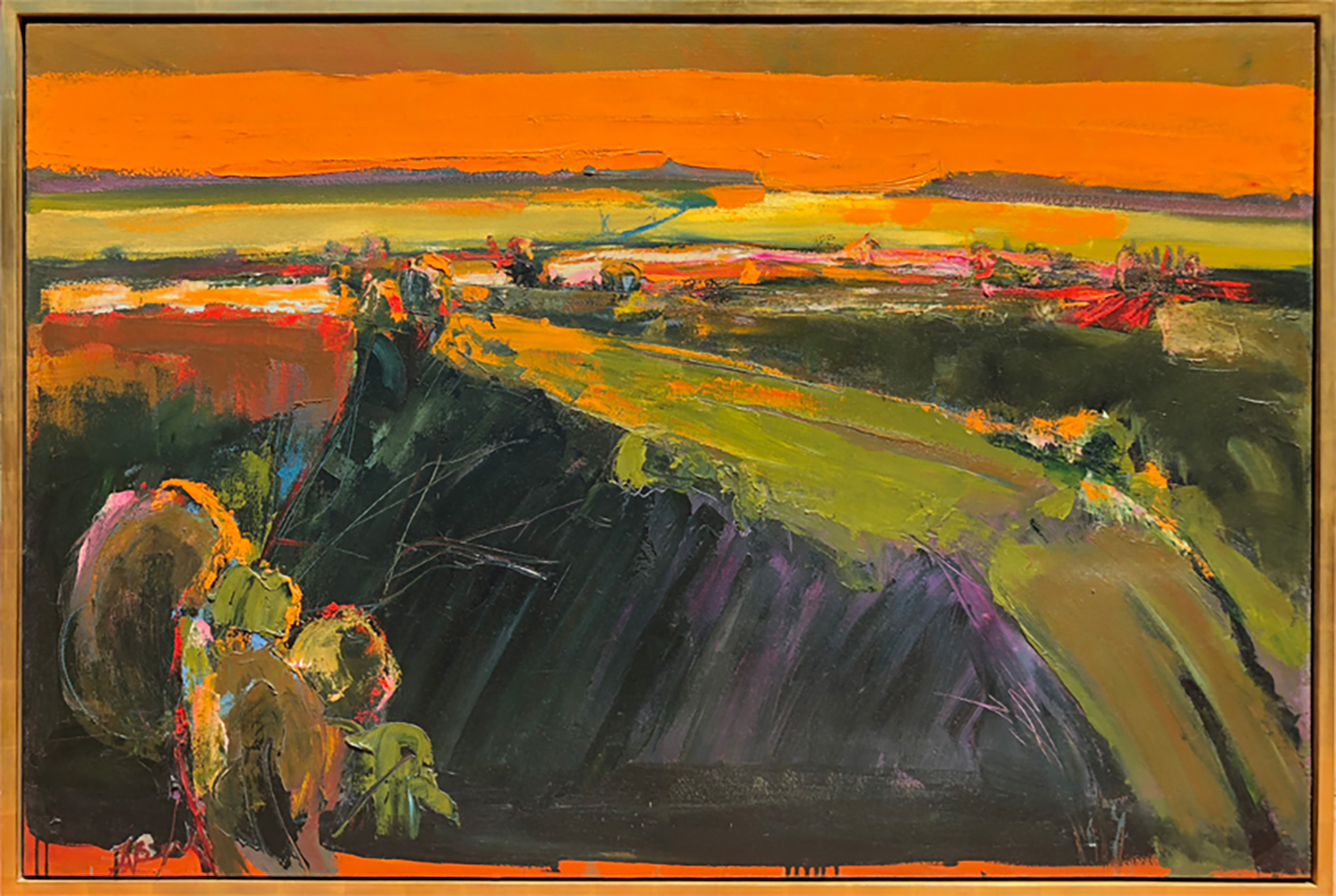Henrietta Berk rejoiced in combining figurative, abstract, expressionist and fauve influences in her paintings. Working from her Oakland, California studio in the 1950s, ’60s and ’70s, she began composing her artworks by squeezing large swaths of brightly colored oils onto the canvasses. She then picked up brushes and palette knives, swirling the paint into portraits, everyday scenes, landscapes and still lifes – while dancing to popular music of the day, an activity maintaining her elegant socialite figure.

Henrietta Berk. Unknown photographer. Gelatin silver print. Courtesy the Oakland Museum of California.
As an intuitive painter whose focus was the freedom, joy and creative delight experienced through artmaking, Berk elicited ongoing praise. Critic Miriam Dungan Cross wrote about her in 1962: “Energy released in interacting color and paint action express her concept of the inner dynamics of all things. This enormous vitality, skillfully contained within the composition, results not only from exuberant contemporary execution, with its lush pigments and happy accidents, but from her vision… .”
If you haven’t heard of Berk (1919-1990), who was well-known in the Bay Area art world during her lifetime, but later faded into oblivion, Mark Hilbert (founder with his wife Jan of the Hilbert Museum of California Art, and Chapman University trustee) is determined to change this situation. After consulting with Santa Monica art dealer Steven Stern, Hilbert recognized the brilliance of Berk’s work.
Stern explained, “One day while searching online auction sites, I glanced at a Berk painting and was awestruck by its exceptional quality. I had stumbled across the most meaningful discovery of my career. After I purchased four Berk paintings, I was amazed at her mastery of color, control of design and confident brushwork, the hallmarks of a highly skilled, well-taught artist. I also discovered her tutelage by artist Richard Diebenkorn, extensive exhibition history, fiery personality and her Hollywood fame, as many prominent actors, musicians and industry icons collected her work.”
Stern also learned that before actively embracing painting, Berk was a traditional 1950s-era housewife and vivacious socialite whose husband was ambivalent about her artistic yearnings. But spurred by her love of art, she began taking evening classes, studying under several Bay Area painters, and soon began achieving prominence in the Northern California art world.

Henrietta Berk, “Beach Sunset,” c. 1966, oil on canvas. On loan to the Hilbert Museum from the Neville and Cindy Johnson Collection.
After purchasing her painting, “Wading,” Stern showed it to Mark Hilbert, explaining his vision to mount a retrospective and to publish a catalogue of her work. “Mark immediately recognized her talent,” Stern said, “stating that he loved the painting, would like to acquire it and hang it prominently in his museum.”
Hilbert added, “When I first saw her work, I was absolutely floored by her brilliant use of color, and her thickly laid-on brushstrokes that add so much texture to her paintings. I bought my first Berk painting shortly thereafter.”

Henrietta Berk, “Floral in Vase,” c. 1962, oil on canvas. On loan to the Hilbert Museum from the Zotovich Family Collection.
In August 2021, the Hilbert Museum opened “Henrietta Berk: In Living Color,” curated by Gordon McClelland, the first major exhibition of her work since 1981. It is the museum’s largest one-person show with 43 paintings from 18 collectors and from Mark and Jan Hilbert’s collection. Museum Director Mary Platt said, “The Hilbert Museum is proud to bring the work of this brilliant artist, who first flourished in an era and in a milieu that challenged woman artists, back to the fore where she belongs.”
“In Living Color,” which is filled with richly textured, colorful oils, depicts Bay Area scenes and portraits while bridging abstraction with representation. Yet Berk’s paintings diverge from the California Scene Paintings that have characterized Hilbert Museum shows since its 2016 opening. The California Scene Painting genre includes oils, watercolors and gouaches featuring landscapes, cityscapes and rural scenes as backdrops for people at work and at play. The paintings focus on culturally relevant settings in California, primarily from the 1930s through the 1970s.
The jaw-dropping “In Living Color,” indicating a broadening of horizons for the Hilbert, is prescient for its future. What new art genres will the museum explore in the coming years, especially after its 2023 expansion with twice as much gallery space?
The Berk exhibition is accompanied by the beautifully illustrated catalog, “In Living Color: The Art and Life of Henrietta Berk.” This literary expression of Stern’s vision elucidates how Berk unearthed her artistic talents and sensibilities, becoming a major figure in the Bay Area art scene and later in Southern California, winning many prizes along the way.

Henrietta Berk, “Picnic,” c. 1962-’64, oil on canvas. The Hilbert Collection.
One of Berk’s earliest paintings, “Me or Façade” (c 1960), a self-portrait of a woman with a red beehive hairdo, illustrates her courageous approach to paint application and bold use of color. She is quoted as saying, ”Color has a profound impact on one’s mood.” Her “Model in Red” (1962), displayed at the exhibition entrance, and possibly another self-portrait, demonstrates Berk’s range of styles and technical proficiency.
“Wading” (1961) features a mother and three children frolicking in the blue and green water with a Northern California landscape forming the background. “Summer Romance” (1962), a poignant scene of a couple relaxing on a beach, comprises broad expressionistic brushstrokes. “Lunch Gossips” (1962) includes brightly clad, fashionably dressed woman enjoying each other’s company during a sun-drenched afternoon. With white impasto paint filling the background, the scene could be from the artist’s own life.

Henrietta Berk, “Oakland Hills,” c. 1967, oil on canvas. On loan to the Hilbert Museum from the Witt Family Collection.
Later paintings – expressionist landscapes in deep reds, oranges, greens and blues – include “View From Clarewood” (1963-65), “Oakland Hills” (1967), “The Valley. Vacaville” (1967) and “Tomales Bay” (1967-69). Her Still Lifes, composed of wild bursts of flowers, some inspired by Russian artist Chaim Soutine, express her bold exploration of painting styles and subject matter.
Berk’s son, observing her artistic process as a small child, is quoted in the catalog: “I was amazed how filled with intent and focused she became in the moment while maintaining a sense of fluidity, grace and power.” Indeed, Henrietta Berk’s prolific artistic output grew from her passion for creativity, from her active social life filled with scintillating events and intense dialogues, and from the many people she appreciated and loved, including her children and friends, and then used as models for her paintings.
“Henrietta Berk: In Living Color” is on view through January 15, 2022. Hilbert Museum of California Art, 167 N. Atchison Street, Orange, CA. Tue.–Sat., 11 am–5 pm. 714-516-5880. Free. www.hilbertmuseum.org
Advertising disclosure: We may receive compensation for some of the links in our stories. Thank you for supporting Irvine Weekly and our advertisers.

